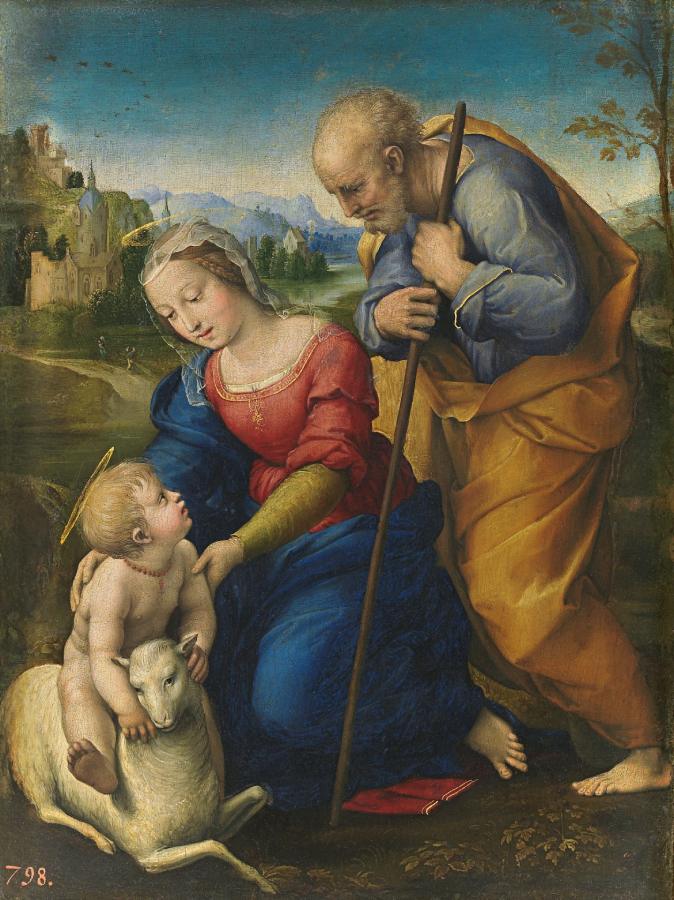Raffaello (1483-1520)
Sacra Famiglia con l’agnello (Holy Family with the Lamb)
1507
Oil on panel, 28 x 21.5 cm
Museo del Prado, Madrid
In 1504, after training with Perugino, Raphael moved from Perugia to Florence, where he remained for four years to absorb the work of Leonardo and Michelangelo. His gradual mastery of classicism is visible in a series of Madonne that constitute a delicate series of variations on the subject of motherly love. One of these is the Holy Family of the Lamb, which is based on a preparatory drawing by Leonardo da Vinci for the main altar at the church of La Annunciata in Florence. While the drawing has been lost and the altar was never made, we know from a letter dated in April 1501 that the composition showed Saint Anne gripping the Virgin, who tries to keep her son from embracing the lamb. This double action was interpreted by the letter’s author, Friar Pietro de Novellara, as the Church -personified by Saint Anne- accepting Christ’s sacrifice -symbolized by the lamb- despite the efforts of the Virgin, who is reluctant to allow it. Like Leonardo’s drawing, of which there is a copy in a private collection in Geneva, Raphael’s panel shows the Virgin, Christ child and lamb, but Saint Anne has been replaced by Saint Joseph. More important than this change is Raphael’s modification of the scene’s implications by depicting the Virgin helping her son embrace the lamb as Saint Joseph looks on with an attentive, meditative expression that reveals his awareness of the action’s premonitory significance. The communication among the characters is emphasized by their postures and the direction of their gazes. The inclusion in the middle ground of a secondary scene with the flight to Egypt suggests that the main subject alludes to a rest on the way.
The landscape is filled with architectural elements that, while present in other contemporaneous works by Raphael, are not Italian, and were probably taken from Northern engravings. In that same sense, the meticulous depiction of nature, especially the plant life in the foreground, suggests that young Raphael had been studying the works of Hans Memling that were in Florence at that time, especially the Pagagnotti Triptych (ca. 1480, Florence, Galleria degli Uffizi). The Virgin’s facial features are unique among Raphael’s works, resembling those of the Madonna dei Garofani, and are explained by the fact that both works draw on models by Leonardo. Fra Bartolomeo has also been suggested as an influence on the depiction of Saint Joseph.
The preparatory drawing for this painting is at the Ashmolean Museum in Oxford. X-rays have revealed changes in the position of the lamb and the Christ child’s hand, as well as the late inclusion of a tree behind Saint Joseph.
This work’s first owner is unknown, although it was recently suggested that he might have been a member of the Montefeltro della Rovere family. Were that the case, the painting could have been made during Raphael’s brief sojourn in Urbino in 1507. Vicente Vitoria placed the work in the Falconieri collection in Rome in 1703 and it entered Spain’s Royal Collection soon thereafter. Some authors identify it as the Rest on the Flight to Egypt by Raphael that painter Carlo Maratta purchased for king Philip V in 1724. From the monastery at El Escorial, it entered the Museo del Prado in 1837 (Text drawn from Falomir, M.: El Prado en el Ermitage, Museo Nacional del Prado, 2011, pp. 70-71).
